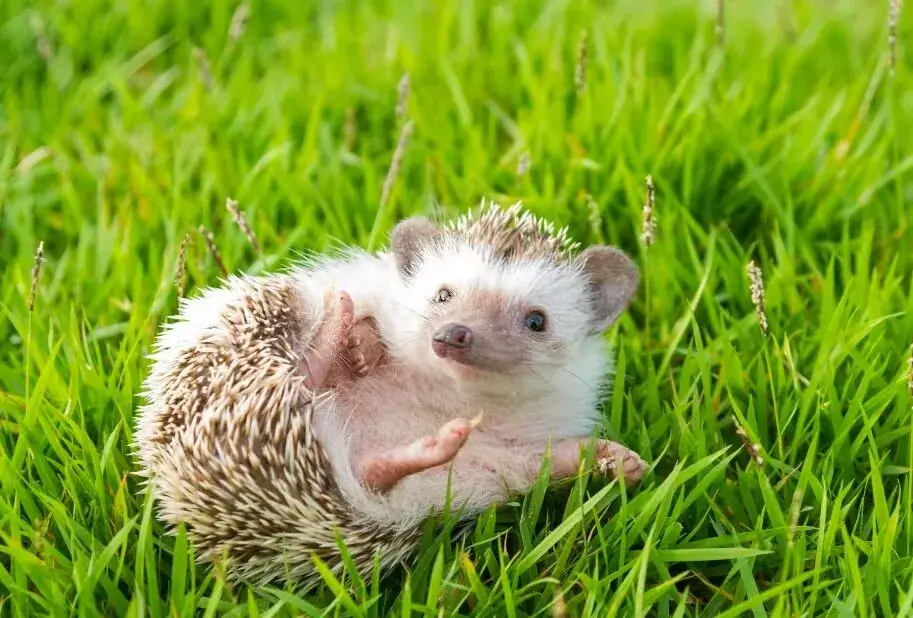Although they are prickly and sensitive, hedgehogs are amazing pets—they are quiet, low-maintenance, and don’t need much space. All a hedgehog needs is a small, warm cage and regular feeding. Most importantly, they bond easily with their owners for life! Pretty sweet, right?
But before you dash to your local breeder and get a hedgehog pet, do your homework. That will enable you to facilitate a fulfilling pet/owner relationship. Here are a few fun facts to get you started.
1. Hedgehogs are Pretty Swift
Anyone who’s ever seen a hedgehog during the day knows these cute animals can be laid back and inactive. Due to this behavior, many often ask themselves: are hedgehogs fast?
A hedgehog can run surprisingly fast and reach up to 4 miles per hour. But for this animal to break its normally leisurely pace and sprint, it has to be startled or threatened. Additionally, a hedgehog can only run for short distances, all thanks to their relatively short legs and stocky bodies.
2. Hedgehogs Have Poor Eyesight
If you have a pet hedgehog, here’s some news. Your buddy can’t see you as clearly as you can see them. But that doesn’t mean it’s blind. Like other members of its species, your hedgehog’s poor eyesight is good enough to register you or any other distinctive landmark as shapes silhouetted against the sky.
But to compensate for poor eyesight, these animals have a fantastic sense of smell and well-developed hearing. So, your hedgehog can use your voice or scent to identify you or find food.
3. A Group of Hedgehogs is Called a Prickle
A hedgehog has a thick layer of thousands of spikes known as quills. Hedgehogs use their quills to protect themselves from predators.
With the above in mind, picture several hedgehogs gathered together in a confined space. Sounds pricky, right? Well, that is one of the reasons why most call a group of hedgehogs a prickle. Some also use this term because prickles refer to sharp points like the quills found on these animals.
4. Hedgehogs Cannot Digest Dairy.
A small quantity of milk can be a nice, healthy treat for pets like dogs or cats, but not hedgehogs. Hedgehogs lack the enzyme for metabolizing the lactose in milk. Simply put, these prickly creatures are lactose intolerant.
If you feed milk to a hedgehog, it will upset its stomach and cause complications like diarrhea. A large amount can lead to serious illness. Try millipedes, crickets, or moist dog food to give your pet a tasty treat.
5. Hedgehogs are Creatures of the Night
When it comes to hedgehogs, the term creatures of the night shouldn’t mislead you into conjuring horrible mental images of dark mythical beings like vampires or werewolves. It simply means they are nocturnal animals.
Hedgehogs are nocturnal animals, a trait they developed to avoid bigger predators like saber-toothed tigers. Fascinating, right? So, if you have one of these urchins, expect it to become fairly busy and lively at night.
6. Hedgehogs Started Evolving Before Humans
Did you know that hedgehogs started evolving approximately 15 million years ago? That’s much earlier than humans. According to scientists, the oldest known ancestors of the present-day hedgehogs are litolestes, whose fossils were discovered in Wyoming and Montana.
That said, hedgehogs have changed little over millions of years. The most distinct feature these urchins have acquired from evolution is a nocturnal way of life.
7. Hedgehogs ARE NOT Porcupines
Some people confuse hedgehogs with porcupines, and for the right reasons. After all, both of these mammals have spiky quills and are common in Asia, Africa, and Europe. Plus, they are creatures that prefer habitats like grasslands and savannas.
However, hedgehogs are completely different from porcupines. One notable difference is that hedgehogs are smaller than their counterparts, and their quills don’t fall off.
Moreover, whereas porcupines are herbivorous animals that love feeding on vegetation, hedgehogs are omnivorous. The latter can eat anything, including fruits, mushrooms, beetles, slugs, and millipedes.
8. Hedgehogs Practice Self Anointing
Have you ever come across a hedgehog licking itself? That’s called self-anointing. The process involves covering the quills with a frothy saliva mixture. Although experts don’t know the exact purpose of self-anointing, some speculate that hedgehogs do it to attract mates, keep off predators, send signals, or kill parasites.
Either way, a hedgehog can go into a trance and take hours to self-anoint. And it will do everything to ensure the foamy mixture is spread all over the body, including bending at weird angles to reach hidden spots. If you see this unusual behavior, don’t be alarmed. These animals do that sometimes for no discernible reasons.
To Summarize
If you love hedgehogs, certain facts should be at your fingertips. For instance, these mammals are nocturnal, omnivorous, and different from porcupines. Moreover, sometimes, they exhibit strange behaviors like self-anointing. Most importantly, hedgehogs are lactose intolerant.

